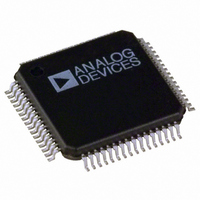ADV7321KSTZ Analog Devices Inc, ADV7321KSTZ Datasheet - Page 57

ADV7321KSTZ
Manufacturer Part Number
ADV7321KSTZ
Description
IC VID ENC 6-12BIT DAC'S 64LQFP
Manufacturer
Analog Devices Inc
Type
Video Encoderr
Datasheet
1.ADV7321KSTZ.pdf
(88 pages)
Specifications of ADV7321KSTZ
Applications
EVD, DVD, SD/PS/HDTV
Voltage - Supply, Analog
2.5V
Voltage - Supply, Digital
2.5V
Mounting Type
Surface Mount
Package / Case
64-LQFP
Input Format
Digital
Output Format
Analog
Supply Voltage Range
2.375V To 2.625V
Operating Temperature Range
0°C To +70°C
Tv / Video Case Style
LQFP
No. Of Pins
64
Msl
MSL 1 - Unlimited
Lead Free Status / RoHS Status
Lead free / RoHS Compliant
Available stocks
Company
Part Number
Manufacturer
Quantity
Price
Company:
Part Number:
ADV7321KSTZ
Manufacturer:
Micrel
Quantity:
2 023
Company:
Part Number:
ADV7321KSTZ
Manufacturer:
ADI
Quantity:
329
Company:
Part Number:
ADV7321KSTZ
Manufacturer:
Analog Devices Inc
Quantity:
10 000
Part Number:
ADV7321KSTZ
Manufacturer:
ADI/亚德诺
Quantity:
20 000
Adaptive Filter Control Application
Figure 75 and Figure 76 show how a typical signal is processed
by the adaptive filter control block in Mode A.
The register settings in Table 35 were used to obtain the results
shown in Figure 76 (to remove the ringing on the Y signal). Input
data was generated by an external signal source.
Table 35. Register Settings for Figure 76
Address
0x00
0x01
0x02
0x10
0x11
0x15
0x20
0x38
0x39
0x3A
0x3B
0x3C
0x3D
Figure 76. Output Signal with Adaptive Filter Control (Mode A)
Figure 75. Input Signal to Adaptive Filter Control
Register Setting
0xFC
0x38
0x20
0x00
0x81
0x80
0x00
0xAC
0x9A
0x88
0x28
0x3F
0x64
Rev. A | Page 57 of 88
When changing the adaptive filter mode to Mode B
[Address 0x15, Bit 6], the output shown in Figure 77 can
be obtained from the input signal shown in Figure 75.
SD DIGITAL NOISE REDUCTION
[Subaddresses 0x63, 0x64, 0x65]
DNR is applied to the Y data only. A filter block selects the high
frequency, low amplitude components of the incoming signal
(DNR input select). The absolute value of the filter output is
compared to a programmable threshold value (DNR threshold
control). There are two DNR modes available: DNR mode and
DNR sharpness mode.
In DNR mode, if the absolute value of the filter output is less
than the threshold, it is assumed to be noise. A programmable
amount (coring gain border, coring gain data) of this noise
signal is subtracted from the original signal. Likewise, in DNR
sharpness mode, if the absolute value of the filter output is less
than the programmed threshold, it is assumed to be noise. If the
level exceeds the threshold and is identified as a valid signal, a
fraction of the signal (coring gain border, coring gain data) is
added to the original signal to boost high frequency components
and sharpen the video image.
In MPEG systems, it is common to process the video information
in blocks of 8 pixels × 8 pixels for MPEG2 systems, or 16 pixels ×
16 pixels for MPEG1 systems (block size control). DNR can be
applied to the resulting block transition areas that are known to
contain noise. Generally, the block transition area contains two
pixels. It is possible to define this area to contain four pixels
(border area).
It is also possible to compensate for variable block positioning
or differences in YCrCb pixel timing with the use of the DNR
block offset.
The digital noise reduction registers are three 8-bit registers.
They are used to control the DNR processing.
Figure 77. Output Signal with Adaptive Filter Control (Mode B)
ADV7320/ADV7321













